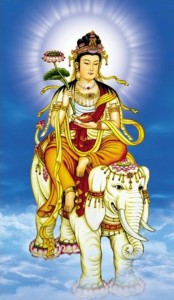Sanskrit: Samantabhadra समन्तभद्र
Tibetan: Kun-tu bzang-po ཀུན་ཏུ་བཟང་པོ
Chinese: Pǔxián Púsà 普賢菩薩
Japanese: Fugen Bosatsu 普賢菩薩
Vietnamese: Phổ Hiền Bồ Tát
Korean: Bohyeon Bosal 보현보살
Samantabhadra Bodhisattva, Universal Worthy, is often depicted riding a white elephant while holding a lotus in the right hand and a sutra in the left hand. Along with Sakyamuni Buddha and Manjushri Bodhisattva, Samantabhadra forms the trinity in Buddhism. In Mahayana Buddhism, Samantabhadra is associated with meditation and Buddhist practice/action.
In the Āvataṃsaka-sūtra, the Buddha states that Samantabhadra Bodhisattva made ten great vows in his path to full Buddhahood. which are the basis of a Bodhisattva:
- To pay homage and respect to all Buddhas.
- To praise the Thus Come One-Tathagata.
- To make abundant offerings (generosity).
- To repent misdeeds and evil karmas.
- To rejoice in others’ merits and virtues.
- To request the Buddhas to continue teaching.
- To request the Buddhas to remain in the world.
- To follow the teachings of the Buddhas at all times.
- To accommodate and benefit all living beings.
- To transfer all merits and virtues to benefit all beings.
The ten vows have become a common practice in East Asian Buddhism, particularly the tenth vow, which many Buddhists traditionally dedicate their merit to all beings during Buddhist services.
